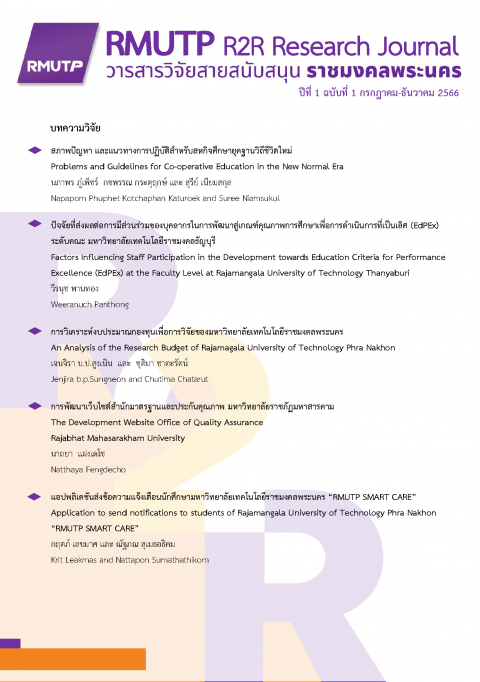The Development Website Office of Quality Assurance Rajabhat Mahasarakham University
Main Article Content
Abstract
The objectives of this research were to 1) design and development Website office of Quality Assurance Rajabhat Mahasarakham University, 2) evaluate website quality of Quality Assurance, Rajabhat Mahasarakham University, and 3) evaluate satisfaction with the use of the Bureau of Standards and Quality Assurance website, Rajabhat Mahasarakham University. The research sample consisted of 2 groups including 1) Experts in information technology will assess the website quality of three expert. 2) There were 10 usabilitytesters who are personnel in the Office of Standards and Quality Assurance, MahaSarakham Rajabhat University and 2) 100 other personnel at MahaSarakham Rajabhat University to assess satisfaction with the website. The tools used in the research included 1) checklist of government website development issues, totaling 28 issues and 2) website satisfaction questionnaire. Statistics used in data analysis included mean and standard deviation. The research results found that: 1) website office of Quality Assurance Rajabhat Mahasarakham University has analyzed and designed the system according to the System Development Life Cycle (SDLC) by using the website content management system (CMS) with ready-made development tools WordPress to develop the website. which is written in PHP language and uses the MySQL database management system. There is a system administrator menu section used to manage various functions on the website. It also supports display in Responsive Design format which can support display on mobile phones and tablets. Content on the website consists of 1) Home page 2) About the organization 3) Plans/ Performance results 4) Announcements/Regulations 5) Downloads 6) Knowledge base and 7) Calendar. 2)The website complies with government website standards, version 2.0, in 26 issues, accounting for 92.86percent. 3) Website users are satisfied with using the website. Overall, it was at a high level (𝑥̅=4.21). When considering each aspect, it was found that website users were most satisfied with using the website, namely content at the highest level (𝑥̅=4.52), followed by is the design and formatting of websites is at a high level (𝑥̅=4.44) and in terms of benefits and applications is at a high level (𝑥̅=4.39), respectively
Article Details
ลิขสิทธิ์ ของมหาวิทยาลัยเทคโนโลยีราชมงคลพระนคร
References
กุลชลี จงเจริญ. 2564. การพัฒนาเว็บไซต์สาขาวิชาศึกษาศาสตร์ มหาวิทยาลัยสุโขทัยธรรมาธิราช. วารสารศึกษาศาสตร์ มสธ, 14(2), 46 -58.
ปรัชญนันท์ นิลสุข. 2546. การประเมินคุณภาพเว็บข้อมูลสารสนเทศ. วารสารรังสิตสารสนเทศ, 9(1), 19-27.
วิชาญ ทุมทอง. (2557). พื้นฐานการพัฒนาสารสนเทศบนอินเตอร์เน็ต ด้วย HTML5 และ CSS3. คณะวิทยาการคอมพิวเตอร์และเทคโนโลยีสารสนเทศ มหาวิทยาลัยราชภัฏรำไพพรรณี.
สำนักงานคณะกรรมการป้องกันและปราบปรามการทุจริตแห่งชาติ. (2565). คู่มือการประเมินคุณธรรมและ ความโปร่งใสในการดำเนินงานของหน่วยงานภาครัฐ ประจำปีงบประมาณ พ.ศ. 2566. (พิมพ์ครั้งที่ 1). กรุงเทพมหานคร : บริษัท กรังด์ปรีซ์ อินเตอร์เนชั่นแนล จำกัด (มหาชน).
สำนักงานรัฐบาลอิเล็กทรอนิกส์ (องค์การมหาชน). (2564). มาตรฐานเว็บไซต์ภาครัฐ เวอร์ชัน 2.0. กรุงเทพมหานคร.
สำนักมาตรฐานและประกันคุณภาพ. (2561). ยุทธศาสตร์สำนักมาตรฐานและประกันคุณภาพ พ.ศ. 2562 – 2564 ฉบับปรับปรุง ครั้งที่ 1 พ.ศ. 2561.
สุจิตรา ด้วงทอง. (2564). ปัจจัยที่มีต่อความพึงพอใจของผู้ใช้บริการเว็บไซต์คณะศิลปะศาสตร์ มหาวิทยาลัยเทคโนโลยีราชมงคลธัญบุรี. Journal of Professional Routine to Research, 8, 25-35
Nichols, V. S. (1996). Inside the world wide web(2ed). California, CA: New Riders Publishing.


